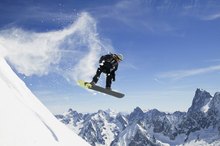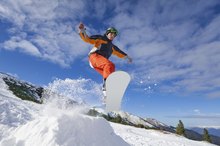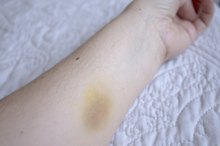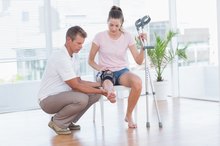Rollerblading for Older Adults
Older adults should strive to maintain the most active lifestyle possible. Doing so can prevent or delay certain diseases such as cancer and diabetes. Improvement of balance, increased mood and quality of life are additional benefits of regular exercise among the older population. Although Today's Senior online magazine says only 1 percent of seniors participate in rollerblading, this activity provides you with an invigorating method of improving overall health.
Benefits for Seniors
Rollerblading benefits older adults in a variety of ways. According to Medline Plus, aging results in stiffer joints, leading to increased pain. Rollerblading as a form of exercise serves as an alternative to activities such as walking or running that place more stress on ailing joints. Regular use of your joints reduces stiffness and allows for increased mobility on a daily basis. In addition, MayoClinic.com reports that one hour of rollerblading burns more than 500 calories and serves as form of weight loss or maintenance for seniors.
Proper Equipment
Physical, Social, Emotional & Intellectual Benefits of Outdoor Recreation
Learn More
Proper equipment is needed to maintain safety while rollerblading. Purchase skates that fit tightly to provide the needed support for bones and ligaments in your ankles. According to the Centers for Disease Control and Prevention, nearly 8,000 adults older than 65 died from a traumatic brain injury caused by a fall in 2005. To reduce the risks, a CSA or Snell certified helmet is essential. Knee and elbow pads protect additional areas prone to injury during rollerblading. Because a wrist fracture is the most common injury while rollerblading, adult-sized wrist guards should be used at all times.
Vision Considerations
Older adults need to take additional safety precautions while rollerblading. According to the journal "American Family Physician," nearly one-third of adults have vision loss by the age of 65. In addition to the typical vision loss that plagues younger individuals, older adults experience additional issues such as macular degeneration or glaucoma. Therefore, only rollerblade during the day and avoid trails that may contain additional hazards such as branches or holes.
Other Medical Considerations
Calories Burned While Snowboarding
Learn More
Osteoporosis is a condition that leads to brittle bones and is not atypical in older adults, especially women. If you experience a fall while rollerblading, you are more likely to fracture a bone if you have this condition. In addition, reduced reflexes may decrease your ability to react if a hazard presents itself while rollerblading. Other cardiovascular conditions such as heart disease or hypertension may make it difficult for older adults to participate in this form of exercise. Speak with your physician before attempting to rollerblade.
Related Articles
References
- Medline Plus: 8 Great "Whys" Seniors Should Exercise
- Texas AgriLife Extension Service: Rollerblading Safety
- Medline Plus: Aging Changes in the Bones, Muscles, Joints
- MayoClinic.com: Exercise for Weight Loss: Calories Burned in 1 Hour
- Centers for Disease Control: Traumatic Brain Injuries can Result from Senior Falls
- American Family Physician: Common Causes of Vision Loss in Elderly Patients
- American College of Physicians: Managing the Elderly with Cardiovascular Disease
- Leeds, Grenville & Lanark District Health Unit: Injury Prevention Summer Safety Rollerblading & Skateboarding
- Today's Senior Magazine: Inline Skating for Older Adults
Writer Bio
Based in Texas, Lucie Westminster has been a writer and researcher since 1975. Her work has been published in journals such as "Psychological Reports" and "Journal of Verbal Learning and Verbal Behavior." Westminster's interests include developmental psychology, children, pets and crafting. She holds a Ph.D. in psychology from Miami University.









